When I logged on Tuesday there was an alert from John Davidson of a lead article at RenewEconomy Coalition energy plan “unworkable”, as Taylor charges into coal. It sent shivers up my spine.
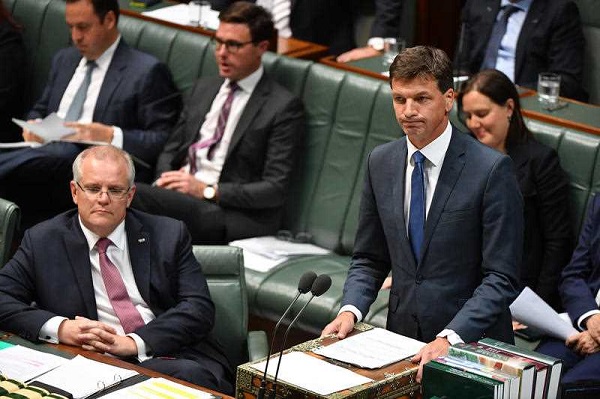
There is PM Scott Morrison, shallow, ignorant and complacent, when first asked about climate change he admitted he’d never really thought about it.
There is Angus Taylor, bull-headed, supremely confident, and just plain wrong.
While Taylor’s “big stick” Treasury Laws Amendment (Prohibiting Energy Market Misconduct) Bill 2018 is the subject of Senate Standing Committee on Economics hearings (see submissions here) he is pressing on with establishing tenders for “24/7” reliable power in what appears to be a mad rush to lock in contracts before the expected “caretaker” period begins in mid April, ahead of the anticipated mid-May poll.
Of the 66 proposals received, 10 include new coal. According to the AFR Taylor has all but confirmed the Morrison government is prepared to underwrite new coal-fired power stations. The proposals mostly include gas, but there is some pumped hydro, plus one from Sanjeev Gupta with a $1 billion proposal for solar with storage.
However, Taylor is known to think we already have too much wind and solar in the system. and is desperate to commit to new coal before the caretaker period of the next election. This will involve Commonwealth underwriting of risk to the extent of $7 billion, a reckless notion when the world is almost certain to realise before such a plant can be built and commissioned that new coal can no longer be tolerated.
Perhaps even worse, having the Commonwealth enter the energy generation market in such a direct and overt way is to completely disrupt state planning, for example in Queensland and Victoria, both of which have vigorous programs of creating new renewable power.
The Australian Energy Council, representing 23 major electricity and downstream natural gas businesses operating in competitive wholesale and retail energy markets, have said the Taylor’s policies, and lack of credible emissions reduction policies, make the generation sector essentially uninvestible. The Council believes that Commonwealth government action will actually reduce private investment in response to the market, thus leading to even more government intervention, with increased prices and adverse consumer outcomes the result.
Queensland considers Taylor’s moves as an attack on the state’s sovereignty (see their submission to the senate hearings above), and points out that there was zero consultation with the states.
NSW energy minister Don Harwin was furious:
- after his federal counterpart Angus Taylor blocked his bid at yesterday’s COAG meeting to discuss a national roadmap to reaching zero carbon output by 2050.
Harwin has said that generation companies which had been planning to invest earlier in 2018 are now getting cold feet after Taylor’s ascension to the ministry post the dumping of Malcolm Turnbull. Taylor’s efforts to reduce risk are adding to risk, because it is obvious to anyone with half a brain that fossil fuel emissions will have to stop long before the 50-year time frame you have to work in to build new coal.
“Yesterday” in the above quote was the COAG Energy Council meeting on 18 December, which Taylor closed down rather than discuss matters raised by NSW. It appears that the Commonwealth minister COAG Energy Council is the permanent chair. I suspect this arrangement was put in place because the Commonwealth was the only member not involved in the provision of electricity generation apart from its historic share in the Snowy Mountain scheme. Ironically now he appears to think it is his meeting.
Back in my day, in such interstate co-operation, the Commonwealth was seen as just one member of the group, and the chair was taken by the host. Possibly the Commonwealth now funds a secretariat, which supports the group and enhanced continuity, but giving the Commonwealth the chair works against the co-operative spirit which is meant to underpin these meetings.
Nevertheless, COAG groups still run on consensus, not on majority vote. The new boy with the big stick is showing no regard for due process.
Today EnergyAustralia chief Catherine Tanna labelled the ‘big stick’ bill ‘desperate and dangerous’. She told the Senate committee it is a “desperate and dangerous” measure by the Morrison government to “look tough” ahead of an election.
- Ms Tanna, who is also a board member of the Reserve Bank of Australia, said that if enacted, the legislation would add a layer of uncertainty on top of the policy vacuum that clouds Australia’s electricity sector.
“It’s like adding a house of cards on a foundation of quicksand,” she said.
Ms Tanna’s comments build on the criticism of the bill on Tuesday by chief executives of other two members of the “big three” generator-retailers, AGL Energy and Origin Energy, who warned the measures would scare off investment needed to replace and renew the country’s energy-supply system.
EnergyAustralia is foreign-owned, so the company has plenty options of investing elsewhere in jurisdictions which don’t carry the same sovereign risk. Also:
-
Energy Security Board chair Kerry Schott has also voiced worries about the impact of the proposed measures on investment needed to support the transition towards a cleaner power supply.
The Grattan Institute, the Business Council of Australia and Australian Industry Group all lined up against the bill. While there is some concern about bad behaviour in the industry, virtually all industry players and interest groups are suggesting that the focus should be on the recommendations of the ACCC report on energy pricing, which did not recommend ‘big stick’ disinvestment.
AEMO has been charting the future of the NEM, so that the participating states and the industry can invest in a smooth transition to a clean energy future. Morrison has effectively put the Coalsheviks within the Coalition in charge. Led by Taylor they are being hugely disruptive, based on the notion that emissions don’t matter, that prices and keeping the lights on do, but completely misunderstanding the role and potential of renewables and the need for flexible dispatchable power, rather than a false notion of baseload.
Also creating a false sense of crisis in which they cast themselves as saviours. It amounts to a mixture of ignorance and stupidity which is making us a laughing stock around the world.
Ootz linked to an epic piece in The Guardian by writer Richard Flanagan:
-
“This is coal,” Morrison began babbling. “Don’t be afraid don’t be scared won’t hurt you won’t hurt you.”
Almost stuttering in his excitement, missing pronouns, he was gibbering without punctuation. If the style was grammatically Joycean, the effect, like his previous masterpiece, “Where the bloody hell are you?”, was memorable.
He waved the piece of coal around like it was the sacred Host itself, he swung it high and he brought it so low that for a moment it was as if a wildly guffawing Barnaby Joyce seated next to him might lick it. How they laughed! The ranks of the Liberal party assembled around and behind, how they all laughed and laughed that day.
Here’s ScoMo handing the lump of coal on to a manic Barnaby Joyce:
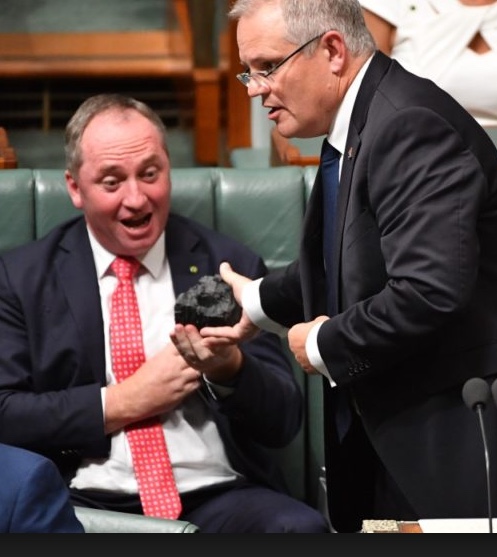
Here’s Joyce ogling over the coal:
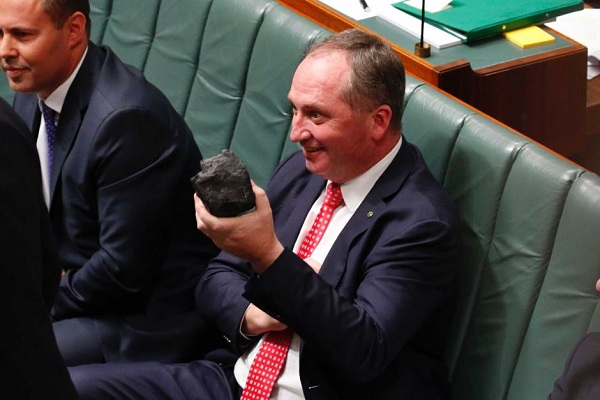
Malcolm Turnbull dumped the NEG (National Energy Guarantee) because he thought it the only way of keeping the Liberal Party together. The real blockage is the Nationals. Joyce is no longer in charge, but the climate denialists reign supreme.
Meanwhile over at the Climate Council they report January was the hottest month ever recorded in Australia, and Farmers are on the front line of climate change, while The Climate Council’s latest report:
-
“Weather Gone Wild” has found climate change is increasing the frequency and/or severity of extreme weather and that Australians are suffering as a result.
“The Coalition Government has been in power for five years and it has obstructed action on climate change while extreme weather worsens. It’s unconscionable,” said Climate Council CEO, Amanda McKenzie
From RenewEconomy, Coal power plants in Australia broke down once every three days in 2018:
- Australia’s fossil fuel generators broke down on 135 different occasions in 2018, with coal generators failing once in every three days and new “HELE” technology favoured by the federal Coalition government failing more often than the country’s ageing black coal fleet.
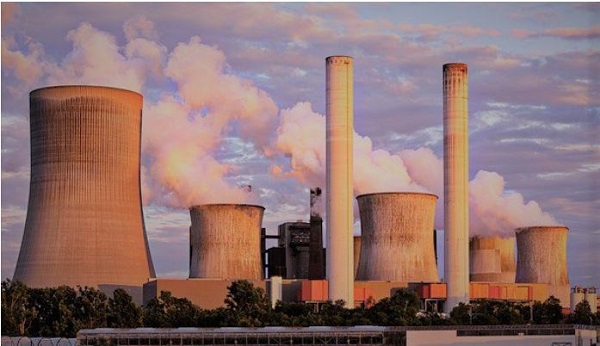
Poor fellow my country.

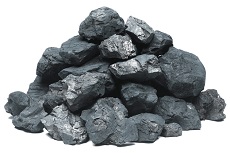
Brian,
The Australian Senate Economics Legislation Committee Treasury Laws Amendment (Prohibiting Energy Market Misconduct) Bill 2018 public hearing transcripts are available here.
Dr Kerry Schott AO, Chair – Energy Security Board and Mr John Pierce AO, Chairman of the Australian Energy Market Commission, were examined in the Feb 5 public hearing in Sydney.
EnergyAustralia’s chief Catherine Tanna was examined in the Feb 6 public hearing in Melbourne.
Interesting reading.
If Taylor thinks we need coal to provide baseload power and gas to provide peaking power he could do something more useful like investing in solar thermal towers with molten salt energy storage and back up molten salt heating. Can be used to provide both baseload and peaking power as required with enough relatively cheap storage to last for days.
I guess he would see not using coal and doing something about greenhouse emissions as a negative but at least he would get some praise from people who don’t usually praise him.
I’ve added at the end of the post:
From RenewEconomy, Coal power plants in Australia broke down once every three days in 2018:
Australia’s fossil fuel generators broke down on 135 different occasions in 2018, with coal generators failing once in every three days and new “HELE” technology favoured by the federal Coalition government failing more often than the country’s ageing black coal fleet.
Geoff, thanks for the link.
It is very clear that the Commonwealth is acting outside the spirit and indeed the letter of the legal arrangements that the National Electricity Market is based on. I was impressed with the performance of Kerry Schott from the ESB and John Pierce of the AEMC. Chris Ketter, Labor Senator, was also well-prepared and sharp. He earned his keep.
The chair was Liberal Senator Jane Hume, who clearly did not understand how electricity prices are set.
Schott did make the point that of most concern was the disincentive to investment that arbitrary atmosphere of Commonwealth intervention and the mooted downgrading of the value of network assets would have when the networks need more investment.
Brian: If I made the comment I really wanted to make on this topic, it could bring a defamation action on you so I’ll refrain from making it …. however, I wonder how many other ordinary people in Australia are seriously thinking about how they can find alternatives to using electricity in their daily lives, and not just thinking of alternatives to coal-fired electricity??
Graham, around here, in this suburb, and many others as far as I can see, refurbishments and mega mansions are being built so there is a tiny back yard. You may be able to walk along one side of the house to get from the front to the back.
The under roof area is massive and it’s airconditioned. In the tiny back yard there is likely to be a swimming pool.
Aircon started to appear on houses where I work in the mid-1990s. Now I can’t think of one that doesn’t have it.
Today in the AFR there is an article Taylor outraged at AGL’s profit. Seeems he’s apoplectic because AGL has just announced a 10% increase for the first half year.
So I did a bit of investigation.
If you read the rest of the article on p22 as distinct from what is on the front page, JP Morgan analyst Mark Busuttil calculates that the profit in the next half year will be down 10%.
I turned up Commsec research. First up, two brokers have AGL as a ‘hold’, one has it as a ‘strong sell’. No-one there has it as a buy.
Further investigation shows that earning per share are at 242 cents. The consensus forecast is that in three years time they will be 134.1 cents. Doesn’t sound like a ‘buy’ or even a ‘hold’. However, they pay a relatively small proportion out as a dividend, and that has been smoothed and gradually increased over the years.
When you look back, the current year’s net profit is almost exactly the same in dollar terms as it was 10 years ago. So in real terms slowly going backwards.
In each of the intervening years, profits have been lower, one year a loss, and quite volatile from year to year.
Now when planning for the future they have a new factor to think about – the state of Taylor’s liver, his gall, which side he got or fell out of bed, what he had for breakfast, and the state of his emotions generally. And his longer term prejudices which are impervious to information or rational reasoning.
Taylor is clearly unfit to be a minister of the crown.
BTW I’m not sure Rod Sims at the ACCC is any better at reading company research either. And the pollies, most of them, might understand negatively geared houses, but it’s rare to hear anyone who isn’t ignorant and confused about the share market.
Posted earlier today in the SMH is an article by Peter Hannam headlined ‘We won’: Landmark climate ruling as NSW court rejects coal mine. It begins with:
The coal dominoes are starting to fall.
Brian (Re: FEBRUARY 7, 2019 AT 11:15 PM)
I’ve seen Kerry Schott in action first hand at the 18 June 2018 public hearing conducted by the NSW Parliament Select Committee on Electricity Supply, Demand and Prices in NSW. I have the impression she knows how to play very well.
This exchange was interesting:
You must wonder what the federal government is playing at: Lack of consultation with energy industry stakeholders; rushed legislation that effectively discourages new investment in the energy market; increasing risks of less reliable and more expensive electricity supply? Does the federal COALition government want to wreak Australia?
Consider the useful contribution to society of the guys in the first image to that of the people who researched and created …. https://youtu.be/yk14dOOvwMk
Posted early this morning at the SMH is an article by Peter Hannam headlined ‘Dire consequences’: Court’s mine rejection sets a climate precedent. It begins with:
It looks like a major legal precedent has been set in NSW that all future planning of coal mines must take into consideration the effect of GHG emissions contributed by the mine. It will be interesting to see whether Rocky Hill developer Gloucester Resources will appeal to a higher court, or cut their losses.
A ray of sunshine announced on Friday, the Rocky Hill coal mine near Gloucester, NSW, has been blocked by the NSW Land and Environment Court. From the Climate Council:
“…the court ruled that a new coal mine would increase greenhouse gas pollution when what is needed to meet the Paris Climate Agreement commitments “is a rapid and deep decrease in greenhouse gas emissions.”
https://www.climatecouncil.org.au/resources/game-changing-legal-decision-on-coal/
Doubtless there will be appeals and a flurry of lobbyists working to undermine the ratio decidendi before the arguments spread to other mine applications, notably the Galillee Basin.
I’m not sure how powerful the decision is and to what extent it will be noted in other courts, but it should have at least some influence. And given the proximity of the coming federal election, it places both major parties at a crossroads – especially the LNP with their blind affinity for coal, and for Labor, a chance to tighten a noose around the LNP neck.
Geoff H, as I explained in Weekly salon 9/2, GHG emissions was not the main reason for the appeal, but the judge was quite explicit that it was important in his finding.
Certainly it was a first.
It’s not like a high court decision obviously, but must carry some weight.
In terms of the Gloucester decision I liked this comment:
In terms of thermal coal at least this puts the future of thermal coal in context.
Coal used for metallurgical purposes is a more difficult issue at the moment because coke is needed for producing iron in blast furnaces. However, blast furnaces are not the only way to produce iron.
As a matter of interest, can a corporation that’s unhappy with a ruling of the Land and Environment Court, take an appeal to a higher court in NSW?
Senior Counsel Google informs me that appeals are possible. Of course. It’s a court.
John
True, and a lot of “ renewable “ components like Silicon for solar panels and others that need that sort of heat to manufacture.
High temperatures may be achieved without combustion of coal. You are aware of that, Mr J, I’m sure.
Yep, but what are you personally prepared to pay extra to end FF consumption ?
We all have a choice to where we allocate our own money ( for the most part but reducing all the time )
At the moment FFs are the cheapest way, to what financial degree are YOU willing to pay extra as an individual ( the base component of every society).
Jumpy/Ambi: The Quartz Corp had this to say about producing high quality silicon metal:
Silicon with different specifications may use coke instead of charcoal as the reductant.
Most electronic uses require very high quality silica but the actual amount used is very very small. (NOTE: The cost of advanced electronics and solar panels is dropping fast.)
Jumpy: I am willing to pay more for fossil free products to give my grandchildren the chance of a good life.
Gosh Jumpy, are you still back at stage one denialism,..”its all going to cost so much BOOO”.
The fact is that it will cost absolutely nothing. Everyone is equally advantaged or disadvantaged. As Syndrome said “I’m going to sell my inventions to make everyone Super,…and when everyone is super, no one will be”
The conversion phase from Fossil Fuel to all renewables is a level playing field for everyone in the same economy where the only impact is time, but measured against progressive destrution of all property I don’t think that matters.
Mind you from this late stage the destruction of most property over the next 100 years is a certainty. And the question then is how quickly can people adapt, and do they really want to keep living in a humid oven hothouse. Birth rates will go down, suicides will go up, things that people today take for granted will be progressively degraded. A good example is the ever increasing prevalence of the Irukanji now reaching past Fraser Island and in the water for up to six months now. How good will that be fro the Gold Coast to have swim free beaches? That is now a certainty, it is just how soon.
As am I. Which raises the question, “Is Jumpy?”
Me too, zoot.
I won’t go into our family’s details*, but let’s say there are several ways most urban and regional families can reduce their
* greenhouse emissions
* use of reticulated water
* consumption of commercial electricity
and power retailers also offer “green electricity” at a small premium….
Then, with an investment of less than $10,000 a family can have a very good solar pv set-up, and/or solar hot water**.
The next big change I want to see, is somehow getting solar pv onto the roofs of rental houses, apartments; and houses owned by very low income Aussies.
* Mr J might call it ‘virtue signalling’, but why should this turn into a p*ssing contest?
** and you save $ every day by doing so.
Pay back period, 4 or 5 years?
That’s a very healthy return on a modest investment, if you can afford to invest.
Cheers, zoot.
Nothing wrong with practical approaches and making some progress.
Fairfax online headline:
Renewables will be main source of global energy by 2040, BP says.
Cheers